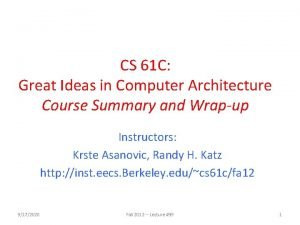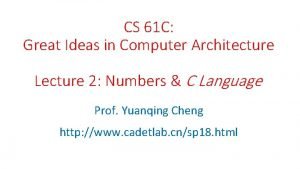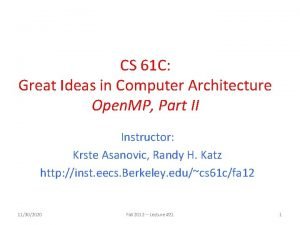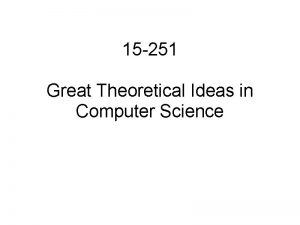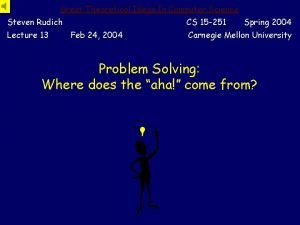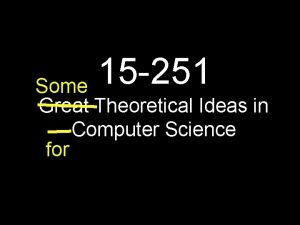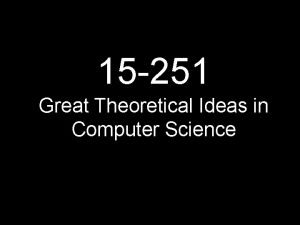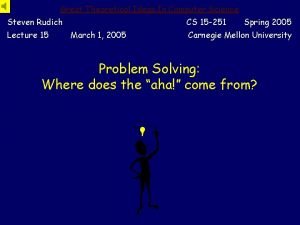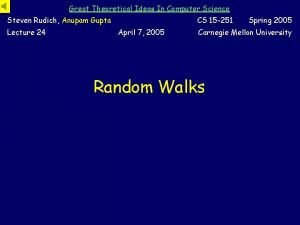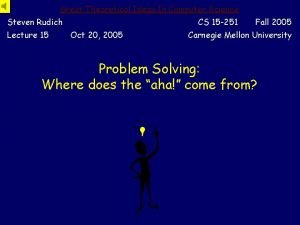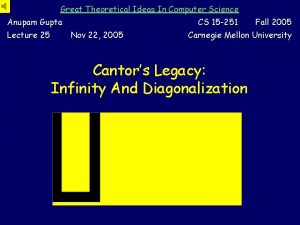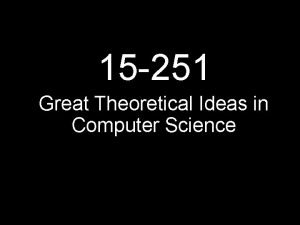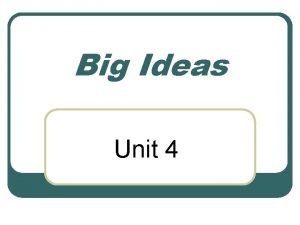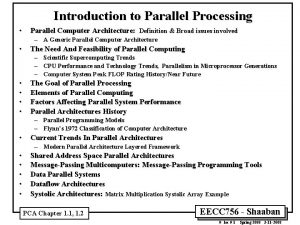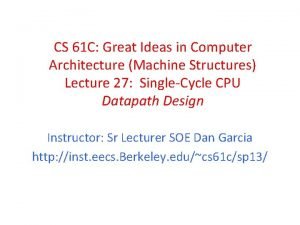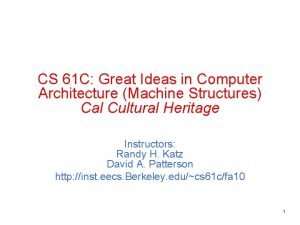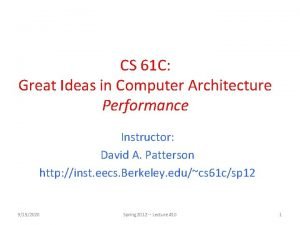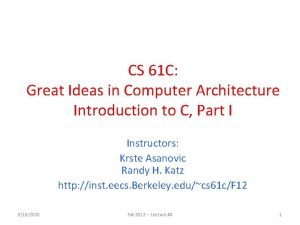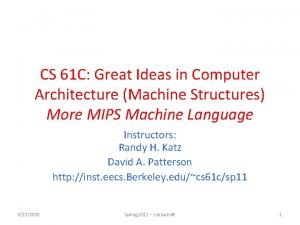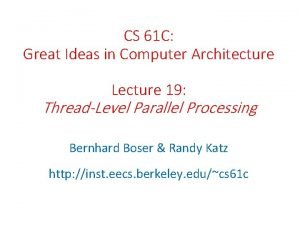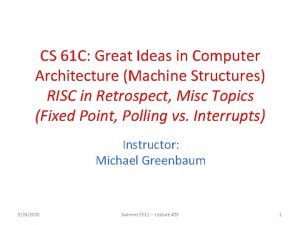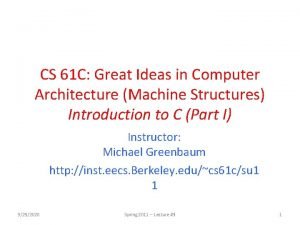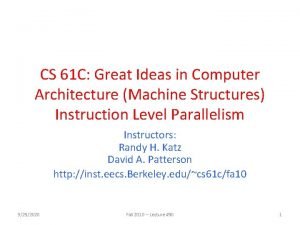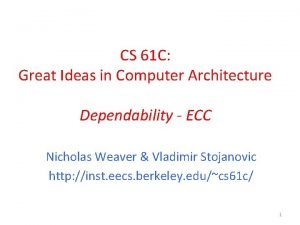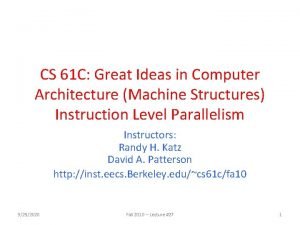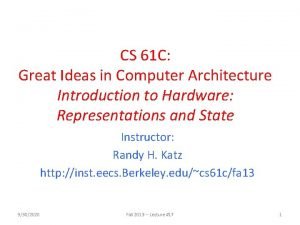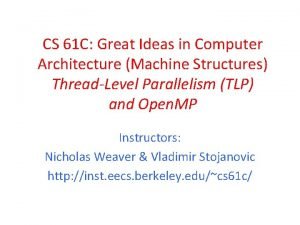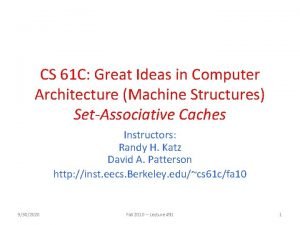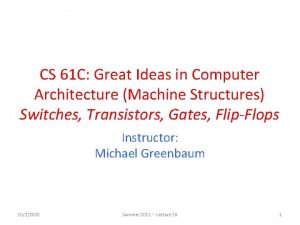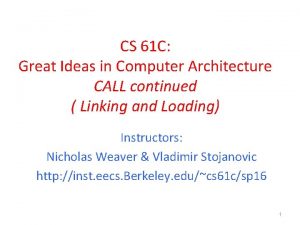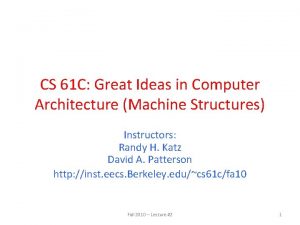CS 61 C Great Ideas in Computer Architecture























































- Slides: 55

CS 61 C: Great Ideas in Computer Architecture Assemblers, Linkers, Compilers Instructors: Krste Asanovic, Randy H. Katz http: //inst. eecs. Berkeley. edu/~cs 61 c/fa 12 9/15/2020 Fall 2012 -- Lecture #12 1

New-School Machine Structures (It’s a bit more complicated!) Software • Parallel Requests Hardware Assigned to computer e. g. , Search “Katz” Harness • Parallel Threads Parallelism & Assigned to core e. g. , Lookup, Ads Smart Phone Warehouse Scale Computer Achieve High Performance Computer • Parallel Instructions >1 instruction @ one time e. g. , 5 pipelined instructions • Parallel Data >1 data item @ one time e. g. , Add of 4 pairs of words • Hardware descriptions All gates @ one time • Programming Languages 9/15/2020 … Core Memory Core (Cache) Input/Output Instruction Unit(s) Core Functional Unit(s) A 0+B 0 A 1+B 1 A 2+B 2 A 3+B 3 Cache Memory Today’s Lecture Fall 2012 -- Lecture #12 Logic Gates 2

Big Idea #1: Levels of Today’s Representation/Interpretation. Lecture High Level Language Program (e. g. , C) Compiler Assembly Language Program (e. g. , MIPS) Assembler Machine Language Program (MIPS) temp = v[k]; v[k] = v[k+1]; v[k+1] = temp; lw lw sw sw 0000 1010 1100 0101 $t 0, 0($2) $t 1, 4($2) $t 1, 0($2) $t 0, 4($2) 1001 1111 0110 1000 1100 0101 1010 0000 Anything can be represented as a number, i. e. , data or instructions 0110 1000 1111 1001 1010 0000 0101 1100 1111 1000 0110 0101 1100 0000 1010 1000 0110 1001 1111 Machine Interpretation Hardware Architecture Description (e. g. , block diagrams) Architecture Implementation Logic Circuit Description (Circuit Schematic Diagrams) Fall 2012 -- Lecture #12 9/15/2020 3

Agenda • • • Review: Performance Assemblers Administrivia Linkers Compilers vs. Interpreters And in Conclusion, … 9/15/2020 Fall 2012 -- Lecture #12 4

Review: Defining Relative CPU Performance • Performance. X = 1/Program Execution Time. X • Performance. X > Performance. Y => 1/Execution Time. X > 1/Execution Timey => Execution Time. Y > Execution Time. X • Computer X is N times faster than Computer Y Performance. X / Performance. Y = N or Execution Time. Y / Execution Time. X = N 9/15/2020 Fall 2012 -- Lecture #12 5

Review: Performance Equation • Time = Seconds Program Instructions Clock cycles Seconds × × = Program Instruction Clock Cycle 9/15/2020 Fall 2012 -- Lecture #102 6

Performance Comparison Mac. Air 3. 1: 1. 6 Ghz Mac. Air 5. 1: 2. 0 GHz 9/15/2020 Fall 2012 -- Lecture #12 7

Performance Comparison Mac. Air 3. 1: 1. 6 Ghz Mac. Air 5. 1: 2. 0 GHz 9/15/2020 Fall 2012 -- Lecture #12 8

Review: Performance Equation • Time = Seconds Program Instructions Clock cycles Seconds × × = Program Instruction Clock Cycle Time 3. 1 = 1/1. 6 Ghz = 625 ns Time 5. 1 = 1/2. 0 Ghz = 500 ns Performance 5. 1 Time 3. 1 625 = = Performance 3. 1 Time 5. 1 500 9/15/2020 Fall 2012 -- Lecture #12 = 1. 25 9

gcc Optimization Experiment Bubble. Sort. c Dhrystone. c Mac. Air 3. 1 No Opt -O 2 Mac. Air 5. 1 No Opt -O 2 9/15/2020 Fall 2012 -- Lecture #12 10

gcc Optimization Experiment Bubble. Sort. c Mac. Air 3. 1 No Opt -O 2 3. 2 s Mac. Air 5. 1 No Opt -O 2 1. 9 s (1. 7 x) 9/15/2020 1. 5 s 0. 8 s (1. 9 x) Dhrystone. c 7. 4 s 3125000 dhrys/s 2. 7 s 8333333 dhrys/s 3. 0 s (2. 4 x) 8333333 dhrys/s (2. 7 x) 0. 7 s (3. 8 x) 25000000 dhrys/s (3 x) Fall 2012 -- Lecture #12 11

Agenda • • • Review: Performance Assemblers Administrivia Linkers Compilers vs. Interpreters And in Conclusion, … 9/15/2020 Fall 2012 -- Lecture #12 12

Converting C to MIPS Machine code $t 0 (reg 8), &A in $t 1 (reg 9), h=$s 2 (reg 18) A[300] = h + A[300]; Format? lw $t 0, 1200($t 1) _ addu $t 0, $s 2, $t 0 _ sw $t 0, 1200($t 1) _ Instruction For mat Student Roulette? op rs rt rd shamt funct address addu R lw (load word) I sw (store word) I 0 35 ten 43 ten reg reg 0 33 ten n. a. address R-type I-type J-type op op op 9/15/2020 rs rs rt rt Fall 2012 -- Lecture #12 rd shamt funct address or constant address 13

Converting C to MIPS Machine code $t 0 (reg 8), &A in $t 1 (reg 9), h=$s 2 (reg 18) A[300] = h + A[300]; Format? lw $t 0, 1200($t 1) _ 35 addu $t 0, $s 2, $t 0 0 _ sw $t 0, 1200($t 1) _ 43 Instruction For mat 9 18 8 8 9 8 8 1200 0 33 1200 op rs rt rd shamt funct address addu R lw (load word) I sw (store word) I 0 35 ten 43 ten reg reg 0 33 ten n. a. address R-type I-type J-type op op op 9/15/2020 rs rs rt rt Fall 2012 -- Lecture #12 rd shamt funct address or constant address 14

Converting to MIPS Machine code Add Loop: ress Format? 800 sll $t 1, $s 3, 2 804 addu $t 1, $s 6 808 lw $t 0, 0($t 1) 812 bne $t 0, $s 5, Exit R 816 addiu $s 3, 1 820 j Loop Exit: I R-type I-type J-type 9/15/2020 op op op rs rs Student Roulette? R I I J rt rt rd shamt funct address or constant address Fall 2012 -- Lecture #12 15

Converting to MIPS Machine code Add Loop: ress Format? 800 sll $t 1, $s 3, 2 804 addu $t 1, $s 6 808 lw $t 0, 0($t 1) 812 bne $t 0, $s 5, Exit R 0 0 19 9 2 0 R 0 9 22 9 0 33 I 35 9 8 0 I 5 8 21 2 816 addiu $s 3, 1 820 j Loop Exit: I 8 19 19 1 J 2 R-type I-type J-type 9/15/2020 op op op rs rs rt rt 200 rd shamt funct address or constant address Fall 2012 -- Lecture #12 16

32 -bit Constants in MIPS • Can create a 32 -bit constant from two 32 -bit MIPS instructions • Load Upper Immediate (lui or “Louie”) puts 16 bits into upper 16 bits of destination register • MIPS to load 32 -bit constant into register $s 0? 0000 0011 1101 0000 1001 0000 two lui $s 0, 61 # 61 = 0000 0011 1101 two ori $s 0, 2304 # 2304 = 0000 1001 0000 two 9/15/2020 Fall 2012 -- Lecture #12 17

Assembler • Input: Assembly Language Code (e. g. , foo. s for MIPS) • Output: Object Code, information tables (e. g. , foo. o for MIPS) • Reads and Uses Directives • Replace Pseudo-instructions • Produce Machine Language • Creates Object File 9/15/2020 Fall 2012 -- Lecture #12 18

§ 2. 12 Translating and Starting a Program Translation Many compilers produce object modules directly 9/15/2020 Fall 2012 -- Lecture #12 19

Assembly and Pseudo-instructions • Turning textual MIPS instructions into machine code called assembly, program called assembler – Calculates addresses, maps register names to numbers, produces binary machine language – Textual language called assembly language • Can also accept instructions convenient for programmer but not in hardware – Load immediate (li) allows 32 -bit constants, assembler turns into lui + ori (if needed) – Load double (ld) uses two lwc 1 instructions to load a pair of 32 -bit floating point registers – Called Pseudo-Instructions 9/15/2020 Fall 2012 -- Lecture #12 20

Assembler Directives (P&H B-5 to B-7) • Give directions to assembler, but do not produce machine instructions. text: Subsequent items put in user text segment. data: Subsequent items put in user data segment. globl sym: declares sym global and can be referenced from other files. asciiz str: Store the string str in memory and null-terminate it. word w 1…wn: Store the n 32 -bit quantities in successive memory words 9/15/2020 Fall 2012 -- Lecture #12 21

Assembler Pseudo-instructions • Most assembler instructions represent machine instructions one-to-one • Pseudo-instructions: figments of the assembler’s imagination move $t 0, $t 1 blt $t 0, $t 1, L → add $t 0, $zero, $t 1 → slt $at, $t 0, $t 1 bne $at, $zero, L – $at (register 1): assembler temporary 9/15/2020 Fall 2012 -- Lecture #12 22

More Pseudo-instructions • Asm. treats convenient variations of machine language instructions as if real instructions Pseudo: Real: addu $t 0, $t 6, 1 subu $sp, 32 sd $a 0, 32($sp) la $a 0, str 9/15/2020 ______________ _______ Fall 2012 -- Lecture #12 Student Roulette? 23

More Pseudoinstructions • Asm. treats convenient variations of machine language instructions as if real instructions Pseudo: Real: addu $t 0, $t 6, 1 subu $sp, 32 sd $a 0, 32($sp) la $a 0, str 9/15/2020 addiu $t 0, $t 6, 1 ______________ Fall 2012 -- Lecture #12 Student Roulette? 24

More Pseudoinstructions • Asm. treats convenient variations of machine language instructions as if real instructions Pseudo: Real: addu $t 0, $t 6, 1 subu $sp, 32 sd $a 0, 32($sp) la $a 0, str 9/15/2020 addiu $t 0, $t 6, 1 addiu $sp, -32 ______________ Fall 2012 -- Lecture #12 Student Roulette? 25

More Pseudoinstructions • Asm. treats convenient variations of machine language instructions as if real instructions Pseudo: Real: addu $t 0, $t 6, 1 subu $sp, 32 sd $a 0, 32($sp) la $a 0, str 9/15/2020 addiu $t 0, $t 6, 1 addiu $sp, -32 sw $a 0, 32($sp) sw $a 1, 36($sp) lui $at, left(str) ori $a 0, $at, right(str) Fall 2012 -- Lecture #12 Student Roulette? 26

Producing an Object Module • Assembler (or compiler) translates program into machine instructions • Provides information for building a complete program from the pieces – Header: described contents of object module – Text segment: translated instructions – Static data segment: data allocated for the life of the program – Relocation info: for contents that depend on absolute location of loaded program – Symbol table: global definitions and external refs – Debug info: for associating with source code 9/15/2020 Fall 2012 -- Lecture #12 27

Agenda • • • Review Assemblers Administrivia Linkers Compilers vs. Interpreters And in Conclusion, … 9/15/2020 Fall 2012 -- Lecture #12 28

Administrivia • Midterm! October 9 th, Evening, 8 PM – 10 PM – 1 hour exam with 2 hours to complete it – Closed notes, book; one 8. 5 x 11” crib sheet, MIPS green card provided – Comprehensive from course start • Lectures, Labs, Projects – There will be a TA-led review session – Special accommodations, contact instructors 9/15/2020 Fall 2012 -- Lecture #7 29

9/15/2020 Fall 2012 -- Lecture #12 30

Get To Know Your Professor 9/15/2020 Fall 2012 -- Lecture #12 31

Agenda • • • Review Assemblers Linkers Administrivia Compilers vs. Interpreters And in conclusion, … 9/15/2020 Fall 2012 -- Lecture #12 32

Separate Compilation and Assembly • No need to compile all code at once • How to put pieces together? FIGURE B. 1. 1 The process that produces an executable file. An assembler translates a file of assembly language into an object file, which is linked with other files and libraries into an executable file. Copyright © 2009 Elsevier, Inc. All rights reserved. 9/15/2020 Fall 2012 -- Lecture #12 33

§ 2. 12 Translating and Starting a Program Translation and Startup Many compilers produce object modules directly Static linking 9/15/2020 Fall 2012 -- Lecture #12 34

Linker Stitches Files Together FIGURE B. 3. 1 The linker searches a collection of object fi les and program libraries to find nonlocal routines used in a program, combines them into a single executable file, and resolves references between routines in different files. Copyright © 2009 Elsevier, Inc. All rights reserved. 9/15/2020 Fall 2012 -- Lecture #12 35

Linking Object Modules • Produces an executable image 1. Merges segments 2. Resolve labels (determine their addresses) 3. Patch location-dependent and external refs • Often slower than compiling – All the machine code files must be read into memory and linked together Fall 2012 -- Lecture #12 9/15/2020 36

Loading a Program • Load from image file on disk into memory 1. Read header to determine segment sizes 2. Create virtual address space (covered later in semester) 3. Copy text and initialized data into memory 4. Set up arguments on stack 5. Initialize registers (including $sp, $fp, $gp) 6. Jump to startup routine • Copies arguments to $a 0, … and calls main • When main returns, do “exit” systems call 9/15/2020 Fall 2012 -- Lecture #12 37

Agenda • • • Review Assemblers Administrivia Linkers Compilers vs. Interpreters And in Conclusion, … 9/15/2020 Fall 2012 -- Lecture #12 38

What’s a Compiler? • Compiler: a program that accepts as input a program text in a certain language and produces as output a program text in another language, while preserving the meaning of that text. • Text must comply with the syntax rules of whichever programming language it is written in. • Compiler's complexity depends on the syntax of the language and how much abstraction that programming language provides. – A C compiler is much simpler than C++ Compiler • Compiler executes before compiled program runs 9/15/2020 Fall 2012 -- Lecture #12 39

Compiled Languages: Edit-Compile-Link-Run Editor Source code Compiler Object code Linker Editor 9/15/2020 Source code Compiler Executable program Object code Fall 2012 -- Lecture #12 2 -40

Compiler Optimization • gcc compiler options -O 1: the compiler tries to reduce code size and execution time, without performing any optimizations that take a great deal of compilation time -O 2: Optimize even more. GCC performs nearly all supported optimizations that do not involve a spacespeed tradeoff. As compared to -O, this option increases both compilation time and the performance of the generated code -O 3: Optimize yet more. All -O 2 optimizations and also turns on the -finline-functions, … 9/15/2020 Fall 2012 -- Lecture #12 41

What is Typical Benefit of Compiler Optimization? • What is a typical program? • For now, try a toy program: Bubble. Sort. c 9/15/2020 #define ARRAY_SIZE 20000 int main() { int iarray[ARRAY_SIZE], x, y, holder; for(x = 0; x < ARRAY_SIZE; x++) for(y = 0; y < ARRAY_SIZE-1; y++) if(iarray[y] > iarray[y+1]) { holder = iarray[y+1]; iarray[y+1] = iarray[y]; iarray[y] = holder; } } Fall 2012 -- Lecture #12 42

Unoptimized MIPS Code $L 3: lw $2, 80016($sp) slt $3, $2, 20000 bne $3, $0, $L 6 j $L 4 $L 6: . set noreorder nop. set reorder sw $0, 80020($sp) $L 7: lw $2, 80020($sp) slt $3, $2, 19999 bne $3, $0, $L 10 j $L 5 $L 10: lw $2, 80020($sp) move $3, $2 sll $2, $3, 2 addu $3, $sp, 16 9/15/2020 addu $2, $3, $2 lw $4, 80020($sp) addu $3, $4, 1 move $4, $3 sll $3, $4, 2 addu $4, $sp, 16 addu $3, $4, $3 lw $2, 0($2) lw $3, 0($3) slt $2, $3, $2 beq $2, $0, $L 9 lw $3, 80020($sp) addu $2, $3, 1 move $3, $2 sll $2, $3, 2 addu $3, $sp, 16 addu $2, $3, $2 lw $3, 0($2) sw $3, 80024($sp lw $3, 80020($sp) addu $2, $3, 1 move $3, $2 sll $2, $3, 2 addu $3, $sp, 16 addu $2, $3, $2 lw $3, 80020($sp) move $4, $3 sll $3, $4, 2 addu $4, $sp, 16 addu $3, $4, $3 lw $4, 0($3) sw $4, 0($2) lw $2, 80020($sp) move $3, $2 sll $2, $3, 2 addu $3, $sp, 16 addu $2, $3, $2 lw $3, 80024($sp) sw $3, 0($2) Fall 2012 -- Lecture #12 $L 11: $L 9: lw $2, 80020($sp) addu $3, $2, 1 sw $3, 80020($sp) j $L 7 $L 8: $L 5: lw $2, 80016($sp) addu $3, $2, 1 sw $3, 80016($sp) j $L 3 $L 4: $L 2: li $12, 65536 ori $12, 0 x 38 b 0 addu $13, $12, $sp addu $sp, $12 43 j $31

-O 2 optimized MIPS Code $L 6: li $13, 65536 slt $2, $4, $3 ori $13, 0 x 3890 beq $2, $0, $L 9 addu $13, $sp sw $3, 0($5) sw $28, 0($13) sw $4, 0($6) move $4, $0 $L 9: addu $8, $sp, 16 move $3, $7 move $3, $0 addu $9, $4, 1. p 2 align 3 $L 10: sll $2, $3, 2 addu $6, $8, $2 addu $7, $3, 1 sll $2, $7, 2 addu $5, $8, $2 lw $3, 0($6) lw $4, 0($5) 9/15/2020 slt $2, $3, 19999 bne $2, $0, $L 10 move $4, $9 slt $2, $4, 20000 bne $2, $0, $L 6 li $12, 65536 ori $12, 0 x 38 a 0 addu $13, $12, $sp addu $sp, $12 j $31. Fall 2012 -- Lecture #12 44

What’s an Interpreter? • Reads and executes source statements executed one at a time – No linking – No machine code generation, so more portable • Starts executing quicker, but runs much more slowly than compiled code • Performing the actions straight from the text allows better error checking and reporting to be done • Interpreter stays around during execution – Unlike compiler, some work is done after program starts • Writing an interpreter is much less work than writing a compiler 9/15/2020 Fall 2012 -- Lecture #12 45

Interpreted Languages: Edit-Run Editor 9/15/2020 Source code Interpreter Fall 2012 -- Lecture #12 2 -46

Compiler vs. Interpreter Advantages Compilation: • Faster Execution • Single file to execute • Compiler can do better diagnosis of syntax and semantic errors, since it has more info than an interpreter (Interpreter only sees one line at a time) • Can find syntax errors before run program • Compiler can optimize code 9/15/2020 Interpreter: • Easier to debug program • Faster development time Fall 2012 -- Lecture #12 47

Compiler vs. Interpreter Disadvantages Compilation: • Harder to debug program • Takes longer to change source code, recompile, and relink 9/15/2020 Interpreter: • Slower execution times • No optimization • Need all of source code available • Source code larger than executable for large systems • Interpreter must remain installed while the program is interpreted Fall 2012 -- Lecture #12 48

Java’s Hybrid Approach: Compiler + Interpreter • A Java compiler converts Java source code into instructions for the Java Virtual Machine (JVM) • These instructions, called bytecodes, are same for any computer / OS • A CPU-specific Java interpreter interprets bytecodes on a particular computer 9/15/2020 Fall 2012 -- Lecture #12 49

Java’s Compiler + Interpreter Editor 7 K Compil er Hello. java Hello. class Interpreter Hello, World! 9/15/2020 Fall 2012 -- Lecture #12 50

Why Bytecodes? • Platform-independent • Load from the Internet faster than source code • Interpreter is faster and smaller than it would be for Java source • Source code is not revealed to end users • Interpreter performs additional security checks, screens out malicious code 9/15/2020 Fall 2012 -- Lecture #12 51

JVM uses Stack vs. Registers a = b + c; => iload b ; push b onto Top Of Stack (TOS) iload c ; push c onto Top Of Stack (TOS) iadd ; Next to top Of Stack (NOS) = ; Top Of Stack (TOS) + NOS istore a ; store TOS into a and pop stack 9/15/2020 Fall 2012 -- Lecture #12 52

Java Bytecodes (Stack) vs. MIPS (Reg. ) 9/15/2020 Fall 2012 -- Lecture #12 53

Starting Java Applications Simple portable instruction set for the JVM Compiles bytecodes of “hot” methods into native code for host machine 9/15/2020 Interprets bytecodes Just In Time (JIT) compiler translates bytecode into machine language just before execution Fall 2012 -- Lecture #12 54

And, in Conclusion, … • Assemblers can enhance machine instruction set to help assembly-language programmer • Translate from text that easy for programmers to understand into code that machine executes efficiently: Compilers, Assemblers • Linkers allow separate translation of modules • Interpreters for debugging, but slow execution • Hybrid (Java): Compiler + Interpreter to try to get best of both • Compiler Optimization to relieve programmer 9/15/2020 Fall 2012 -- Lecture #12 55
 Eight ideas in computer architecture
Eight ideas in computer architecture 8 great ideas in computer architecture
8 great ideas in computer architecture 8 great ideas in computer architecture
8 great ideas in computer architecture 8 great ideas in computer architecture
8 great ideas in computer architecture Great theoretical ideas in computer science
Great theoretical ideas in computer science Great ideas in theoretical computer science
Great ideas in theoretical computer science Great theoretical ideas in computer science
Great theoretical ideas in computer science Cse 111
Cse 111 Great theoretical ideas in computer science
Great theoretical ideas in computer science Great theoretical ideas in computer science
Great theoretical ideas in computer science Great theoretical ideas in computer science
Great theoretical ideas in computer science Steven rudich
Steven rudich Great theoretical ideas in computer science
Great theoretical ideas in computer science Great theoretical ideas in computer science
Great theoretical ideas in computer science Great theoretical ideas in computer science
Great theoretical ideas in computer science Bus design in computer architecture
Bus design in computer architecture Difference between computer architecture and organisation
Difference between computer architecture and organisation Basic computer organization
Basic computer organization Ideas have consequences bad ideas have victims
Ideas have consequences bad ideas have victims Los deseos ridículos preguntas y respuestas
Los deseos ridículos preguntas y respuestas Unit 4 great ideas
Unit 4 great ideas Turning great strategy into great performance
Turning great strategy into great performance Great places great faces
Great places great faces With leadership comes great responsibility
With leadership comes great responsibility Great white hammerhead
Great white hammerhead Does alexander the great deserve his title
Does alexander the great deserve his title Frederick the great education
Frederick the great education With great expectations comes great responsibility
With great expectations comes great responsibility A great deal vs a great many
A great deal vs a great many With great power comes great responsibility
With great power comes great responsibility Does alexander deserve to be called the great
Does alexander deserve to be called the great Great is thy faithfulness oh god my father
Great is thy faithfulness oh god my father Software architecture definitions
Software architecture definitions Call and return architecture in software engineering
Call and return architecture in software engineering Product architecture design
Product architecture design Integral vs modular design
Integral vs modular design Computer organization and architecture 10th solution
Computer organization and architecture 10th solution Intel pentium
Intel pentium Coa virtual lab iit kharagpur
Coa virtual lab iit kharagpur Introduction to computer organization and architecture
Introduction to computer organization and architecture Timing and control in computer architecture
Timing and control in computer architecture Computer architecture: concepts and evolution
Computer architecture: concepts and evolution I/o modules in computer architecture
I/o modules in computer architecture Fp adder
Fp adder Immediate addressing mode
Immediate addressing mode Static interconnection network in computer architecture
Static interconnection network in computer architecture Smt computer architecture
Smt computer architecture Mul mips
Mul mips Collision vector in pipelining
Collision vector in pipelining Instruction format in computer architecture
Instruction format in computer architecture Nano control memory
Nano control memory Difference between symbolic and binary microprogram
Difference between symbolic and binary microprogram Memory system design in computer architecture
Memory system design in computer architecture Virtual memory tlb
Virtual memory tlb Difference between linear pipeline and non linear pipeline
Difference between linear pipeline and non linear pipeline Computer architecture definition
Computer architecture definition

